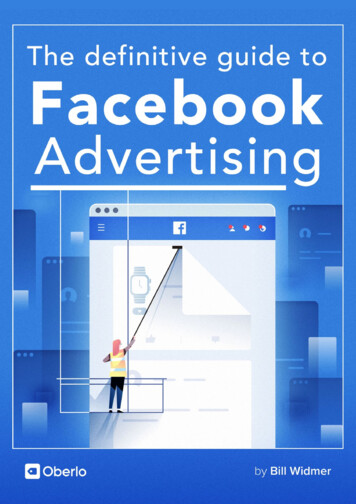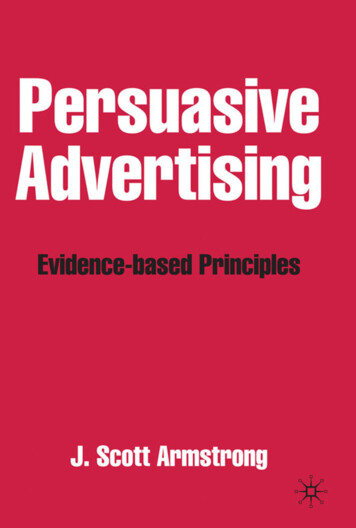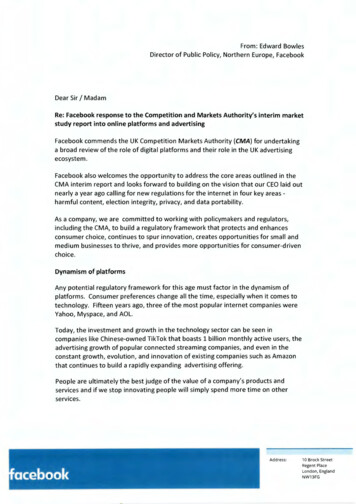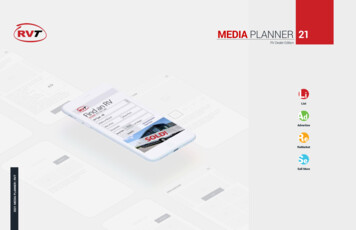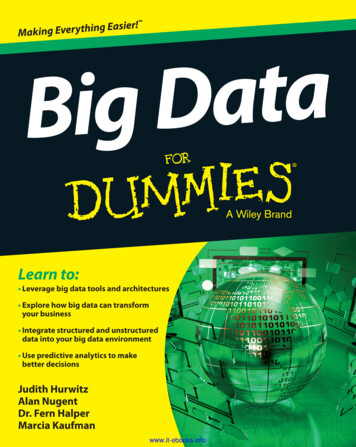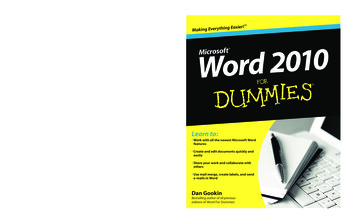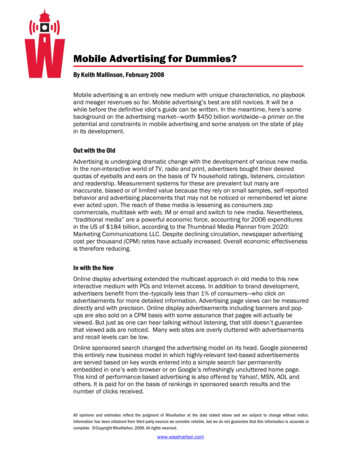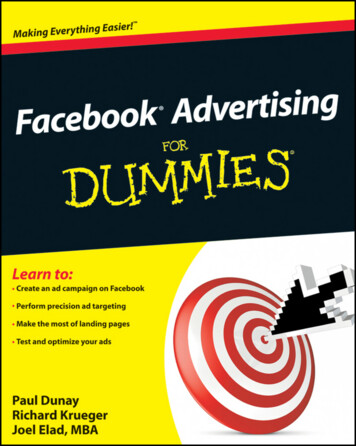
Transcription
Facebook AdvertisingFor DummiesChapter 1Profiting from the Facebook RevolutionISBN: 978-0-470-63762-3Copyright of Wiley Publishing, Inc.Indianapolis, IndianaPosted with Permission
Chapter 1In This Chapter Discovering what Facebook advertising offersTERIALProfiting from the FacebookRevolutionMA Seeing the similarities between Facebook and other advertising Identifying the unique functions of Facebook advertisingD Understanding the direct and relationship marketing aspects of Facebook AdsTETPYRIGHhe old adage in real estate is that the three most important qualities of aproperty are “Location, location, location.” Many say the same thing aboutadvertising as we watch ads pop up (and under) all over the place. You can’twatch a NASCAR race, drive along the road, read a magazine, or listen to theradio without hearing, seeing, or experiencing a message from an advertiser.Naturally, advertisers want to be where people are, and incorporate their products and messages into everyday life, from the bus stop bench to the clock onyour doctor’s office wall. As the World Wide Web has evolved, and more andmore people incorporate the Internet into their daily lives, advertising naturally followed them online. And the Web has never been the same.COOnline advertising has experienced a phenomenal growth, from the earlydays of text-only ads to the online streaming videos and media-rich adsthat we can see today. In that time, advertising has taken on different forms(banner ads, pop-up ads, pop-under ads, everything but the Pop-Tarts ad)and different ways of charging the advertiser. One of the main functions ofadvertising, though, has been that ads allowed popular content to stay free ofcharge for users on the Internet. People got to host their own Web sites, havefree e-mail accounts, and carry on all sorts of discussion with ad-supportedWeb sites and companies. In fact, the most popular Web sites today are thesearch engines, like Google and Yahoo!, that help direct people to what theyare seeking on the Internet and receive a lot of revenue from the ads displayed alongside the search engine results.Today, the hottest category of Internet usage for most people is the socialnetworking space, where people use social Web sites to stay connected andcommunicate with their friends and colleagues. The current leader in personal
10Part I: Getting Started with Facebook Advertisingsocial networking is Facebook, with more than 500 million members as of thiswriting. Members can talk to their friends, share photos and stories, comment on each other’s status, and join groups and discussions on their favorite topics. Facebook also has third-party applications that run on its site,allowing people to take and share quizzes, play online games, and supporttheir favorite causes. Alongside all this activity and discussion, quietly andunobtrusively placed, are advertisements that anybody can purchase, create.and launch by using Facebook advertising.Facebook is in a unique position: It has a wealth of information about itsusers, with more content being generated daily, and Facebook has figuredout how to allow advertisers access to that information without affecting theprivacy of any particular user’s sensitive data.In this chapter, we talk about the basics of Facebook advertising, from whatan ad looks like to its basic structure and placement, and the different typesof ads and pricing models that Facebook offers. We cover some of the basicprinciples Facebook Ads uses that are similar to other online advertisingsites, as well as highlight some of the unique aspects that Facebook offers totheir advertisers. We end the chapter by discussing the two types of marketing an advertiser should keep in mind when using Facebook Ads: direct marketing and relationship marketing. By showing you all of these concepts, wewill demonstrate that Facebook Advertising gives you the power to advertiseyour exact message to your exact audience in a hip and non-threatening environment, which should be any marketer’s dream.Introducing Facebook AdvertisingWhen you use Facebook, whether you’re on your home page, reading comments on your Friends’ Walls, or playing your favorite online Facebook game,you’ll probably notice at least one advertisement, usually on the right sideof the page. These are Facebook Ads, and they are available to anyone withan advertising budget, from 1 to 1 billion. (That last option is probably justfor Dr. Evil from Austin Powers.) Large advertisers, such as Pepsi, Proctor &Gamble, and Walmart, run ads on Facebook, but it also offers a great opportunity for many small businesses. A quick look at the Facebook for BusinessPage (see Figure 1-1) shows ads from companies like Nike to a company selling eBay auction templates.Every advertisement on Facebook has the same four core elements: A title (25 characters or fewer) An image (optional but we strongly recommend having one; 110 x 80 pixels) The ad copy or message (135 characters or fewer) A link to a Facebook or other Web page (when someone clicks the ad)
Chapter 1: Profiting from the Facebook RevolutionFigure 1-1:FacebookAds appearalong theright side ofthe page.Facebook also adds a link entitled Like to do one of two things. If the advertiser is promoting a Facebook business Page, then clicking Like will addthat user to the Facebook Page as a Fan. Otherwise, this link let users votewhether they like the advertisement. This is one way how Facebook enablesits community to help police the types of ads that get displayed on the site. Italso adds an interactive nature to the ads because when someone clicks theLike link for an ad, their friends find out that the person liked the ad, whichmay prompt some friends to view the ad as well.If you’re a Facebook member, you’ve likely seen ads displayed on the rightside of most Facebook Pages. These ads include a headline, an image, andbody copy (text). As we mention earlier, Facebook also includes a Likelink with which members can either join a Facebook Page or express theirthumbs-up approval for the ad. Like most traditional display ads, the user isthen redirected to another page within Facebook or an external Web site.Increasingly, Facebook Ads also include an option to engage in a socialaction, such as “Like,” or “RSVP to this Event,” like in Figure 1-2. Ads thatinclude a social action are referred to as social ads or engagement ads. Socialads can even include a video (instead of a still image) that allows the user toview the video from directly within the ad unit.11
12Part I: Getting Started with Facebook AdvertisingA Sponsored social ad inviting visitors to “click the bucket”Figure 1-2:A socialad offersvisitorsthe abilityto engagein a socialaction.On your Facebook home page, only one ad appears as the Sponsored ad, asshown in Figure 1-2. For most other Facebook Pages — also called Rest-of-Sitepages — you should see at least three ads along the right side of the page,named the Ad Space.Finding Your Way aroundFacebook AdvertisingWhen you’re ready to use Facebook Ads, start by going to its home page(www.facebook.com/ads), as shown in Figure 1-3.Your Facebook Ad account will be tied to either your personal Facebookaccount or your Facebook Pages account, which is tied to your business. Wewalk you through how to create your own Pages account in Chapter 2. Afterthese accounts are set up, Facebook walks you through the four-step processof building your own Facebook Ad:
Chapter 1: Profiting from the Facebook RevolutionFigure 1-3:Start at theFacebookAdvertisinghome page.1. Design your ad.a. Write your title and ad message (or body text, as Facebook calls it).b. Attach an image to be included in the ad.c. Designate an internal Facebook Page or external Web page.2. Target your ad.Use Facebook’s different target filters to assign the specific audiencethat you want to view your ad.3. Price your ad.You designate a campaign name for your ad, set a budget for that ad,and decide whether to use a CPC or CPM pricing model when the ad isdisplayed. (Read more about CPC and CMP pricing in later chapters.)4. Review your ad.You go over all the information you entered in Steps 1–3, and make surethe ad is to your liking. After you review everything and make sure thatit’s correct, you submit the ad to Facebook for approval.You can read about all these steps in more detail in Chapter 2.13
14Part I: Getting Started with Facebook AdvertisingSeeing the Familiar Aspectsof Facebook AdvertisingCertain elements of Facebook advertising are very similar to other ad solutions out there, like Google AdWords. Some of these elements — such aswriting your own advertising messages (a catchy title, some enticing call toaction) and managing your own advertising budget (setting ad bid prices,doing daily or total ad budgets) — are proven winners that simply makesense for an online advertiser and create a better experience and return oninvestment (ROI).Because of these similarities, anyone with some experience in online advertising can use the Facebook Ad platform with no sharplearning curve. Later, we discuss some of the unique aspects of FacebookAdvertising to further demonstrate the power and reach of this platform.Design your own advertisementsWhen running an ad on Facebook, it’s time to channel your inner Don Draper(from the AMC TV show Mad Men) and come up with your own design. Afterall, it’s up to you to write your own ad. And this is a good thing becauseyou’re the one writing an ad that speaks directly to the customer you’retrying to attract instead of having to pick from templates or stale prescriptedmessages. You’re free to design targeted advertisements that match yourgoals, product catalog, or intended cause.Facebook guidelines, however, do govern what you can and cannot put inan ad. Most of these guidelines have to do with protecting other people’scopyrighted or trademarked information; or preventing anything obscene,offensive, or illegal from being displayed. Failure to abide by these guidelinescan result not only in your ad not running but even removal of your Facebookaccount. You can find out more at the Facebook Ad Guidelines page at www.facebook.com/ad guidelines.php.Manage your own ad budgetWith Facebook Ads, like other ad systems, you can set your own daily,weekly, monthly, or yearly budget, so you have virtual control over howmuch you spend. This allows you to plan your ad campaigns so you knowyour ads will be on Facebook during specific periods of time. Too, you keepyourself from spending your entire yearly ad budget in one or two days.By managing your own ad budget, you can also decide when to spend more orless based on how effective your ads are performing. We discuss this strategyin Chapter 4 when we talk about how to calculate the effectiveness and ROI ofyour ads.
Chapter 1: Profiting from the Facebook RevolutionOf course, the value of being able to manage your own advertising budgetoccurs only when you take the time to decide when and how much to spendon your advertisements. Before you start running any major campaign, askyourself a few questions: How much money do I have, total, to spend on Facebook advertisements? What percentage of my overall ad budget will I dedicate toFacebook Ads? How long do I want this ad campaign to be visible on Facebook? For what specific dates or timeframes will I need extra visibility orspending?After you’ve thought about total spending, decide your per-ad spending.Many online advertising systems, including Facebook, have a bidding systemfor determining an ad’s price. A bidding system is a method in which theadvertiser defines the ad they wish to run and then create and enter theirown bid price, which they are willing to pay the ad system for running this adon that ad system. The bidding system will also look at any competing advertisements in their system inventory and suggest a bidding price or biddingrange for this new ad request that the ad system would likely accept.Facebook bases its ad pricing on a closed bidding system. This means thatyou can’t see what others are bidding for ads, nor can they see your bids.Facebook provides a recommended bidding range, although you can chooseto under or overbid their suggested range. However, if your cost is too low,the ad will not appear. Sometimes a penny too low on a bid can mean the difference between an ad being seen and one that isn’t.Similar to other systems, you have two different methods you can use to bidfor your ads: CPC (cost per click): This is the method most often used, preferred byadvertisers who closely track the performance of their ad. In the CPCmethod, the advertiser doesn’t pay until a potential customer clicksthe ad and is taken to the intended target page of that ad. This way, theadvertiser doesn’t pay every time an ad is merely displayed, and eachclick can be tracked to see whether that potential customer performedany action after clicking the ad. CPM (cost per [thousand] impresssions): This method was how onlineads were originally paid for by advertisers. Whenever Facebook displaysyour ad, that counts as an impression against your ad budget. You canbid on the rate charged per 1,000 impressions.Some advertisers still opt for this method, especially in cases wherethey are looking for visibility instead of getting the customer to performa specific action. The cost is much less with CPM because the advertiseris not paying for performance.15
16Part I: Getting Started with Facebook AdvertisingFor those of you wondering why cost per thousand is abbreviated as CPMinstead of CPT, the M refers to the Roman numeral system, in which M standsfor 1,000.We discuss more about CPC and CPM, as well as specific bidding strategiesfor both models, in Chapter 4.Understanding Unique Aspectsof Facebook AdvertisingThe most recent Interactive Advertising Bureau (IAB) Revenue Report(done by PricewaterhouseCoopers) estimated that 22.7 billion was spenton Internet advertising in 2009. Ten years ago, the estimates on Internet adspending ranged from 1–2 billion. Part of this phenomenal growth is attributable to Internet companies figuring out bigger and better ways of servingthe advertiser more — and, in most cases, better — information that advertisers can use in their efforts. As Internet technology has improved, Web siteshave been able to incorporate images, then audio, video, and Flash technology into their ads to make them more attention-grabbing and user-friendly.Search engines were able to relay keywords typed in as a user’s intent andgeared ads targeted for those keywords.Facebook Ads, unlike other ad systems (such as Google AdWords) can provide some great features for their advertisers mainly because of one thing:information. Facebook sits on a mountain of information about each of itsusers, from user profile information to the discussions, groups, and otherads that each user clicks or fills out while using Facebook. New information isgenerated daily, and Facebook has figured out how to harness that information in a way that shields the privacy of each particular user’s sensitive datawhile providing a richer experience for the advertiser.Targeting profile attributesIf you’re designing an ad for a search engine like Google or Yahoo!, the mostyou know about your viewer is typically the keyword(s) that user types whenusing the search engine. Therefore, your ad has to be attractive to those visitors using those keywords as you try to figure out whether your product orservice matches what they’re searching for.With Facebook, however, you can know a lot more about each person whowill potentially view one of your ads. The typical Facebook user completes anextensive profile that tells the world (or just their Friends) everything from
Chapter 1: Profiting from the Facebook Revolutiontheir Interests, Likes, and Dislikes to their Age, Gender, and Marital Status.Because this information is stored in each Facebook user’s profile, Facebookcan offer its advertisers the ability to target specific profile attributes so thatyou, the advertiser, can set very specific audiences for your ad.Say, for example, that you’re trying to advertise a shop that sells weddingdresses in Los Angeles. With other ad systems you might run search engineads targeting phrases like wedding dress or getting married, but with Facebookyou can actually tell Facebook to display your ad only to those 35,620Facebook users (see Figure 1-4) who are Women, 25 to 44 years old, whoseMarital Status is Engaged, and whose location is Los Angeles or a surrounding area.Facebook has 11 profile attributes that you can set for each ad, includinglocation, age, sex, education, and so on. For more on this, see Chapter 2.Targeting your audience is as important as the message itself. Develop personas to represent your target audience. Learn what they’re interested in —their educational background, relationship status, and where they live. Reachonly the audience you desire by leveraging Facebook’s targeting to meet yourideal customer profile.Figure 1-4:Target theexact userswho will seeyour ad.17
18Part I: Getting Started with Facebook AdvertisingUsing clickable ads that don’t leavethe original Web pageThe design of most online advertisements is to redirect the viewer to a specific Web page, or pop open a new tab or window to get to a message thatthe advertiser wants the viewer to see and then hopefully perform some sortof action. This is why we discuss landing pages at various places throughout this book, primarily in Chapter 7. However, some Facebook Ads offer afeature not possible with other systems: namely, the ability for the viewer toclick the ad, perform the call to action (what you want the viewer to do), andnever be taken off the original Web page where the ad was displayed.With Facebook Ads for Pages and Events, the ad actually includes anotherelement not found in other ads. That extra element is a button or link thatthe user clicks to perform the necessary action on Facebook’s server. Thisbutton or link then changes to a confirmation message when the action iscomplete — and, most importantly, never updates, redirects, or changes theWeb page that the user was on when the ad was clicked.For example, take the ad for AllPosters.com in the left side of Figure 1-5. Ifyou click the Like link, the ad subtly changes, replacing the link with a confirmation message (You like AllPosters.com, as shown on the right side ofFigure 1-5), but the rest of the page stays the same, allowing the customer togo about their Facebook experience as usual.Figure 1-5:You caninteract withFacebookAds withoutleaving thepage!
Chapter 1: Profiting from the Facebook RevolutionThis feature is significant because it enhances the relationship marketingaspect of Facebook Ads. You, the advertiser, can interact with new customers without interrupting their daily activity. You become part of their overallexperience as they are added to your Fan page or event RSVP list withoutlosing track of their everyday Facebook interactions. The immediate confirmation of the action without the jarring effect of the visitor being moved to a newWeb page often means that user is more likely to stay with that advertisers’brand in the future.Gathering responder informationwith Facebook InsightsIf you’re going to advertise on Facebook, we highly recommend having a Pageon Facebook as well. (We talk about how you can build a Facebook Page foryour business in Chapter 2.) Not only will having a Page include you in anongoing conversation with your customers and visitors by using Facebook,but it also gives you more information that you can use to update and refineyour ads.Facebook keeps track of visitor information for your business Pages throughan interface called Facebook Insights. You can see user exposure, actionstaken, and behavior related to either your social ads or your business Page,which allows you to monitor trends so that you can better gauge the effectsof your ads beyond the common metrics of click-through rate and CPC.We discuss the ins and outs of Facebook Insights, and how to use the data toupdate your ad campaigns, in Chapter 8.Direct and Relationship MarketingAspects of Facebook AdsAs you begin to use Facebook Ads to create and run your ad campaigns, youshould understand two of the basic marketing disciplines that are cominginto play in your efforts to reach the consumer: Direct marketing Relationship marketing19
20Part I: Getting Started with Facebook AdvertisingYour individual ads and ad campaigns are very much a direct marketing effort.You have specific goals, messages, and offers in mind, and you can measurethe cost, ROI, and effectiveness of each ad that you run. Here, you are thinkingabout how each ad is acted upon and how it directly affects your business.However, your presence in general is more of a relationship marketing effort.You’re not simply running ads to get a one-time sales bump and then fadeaway. Your goal with these ads is to increase overall usage in your company’s products, brand image, or even your Facebook presence.Therefore, keep both disciplines in mind while you devise and implementyour advertising strategy. The best success stories come from businessesthat play to both these discipline’s strengths while understanding the benefits their ad campaigns can bring in dollars as well as good will and brandpresence.How direct marketing techniquesaffects your advertisementsFacebook is an ideal direct marketing channel, offering direct marketers acost-effective buy and easy-to-deploy testing environment from which tohone in on their target audience and refine the message. Direct marketingis a science in which measurement of response is an essential component.Facebook provides a platform from which to experiment and measure theresults almost instantly.It’s no wonder that direct marketers are flocking to Facebook. When measuring results, a one percent difference in outcome could easily translateinto hundreds or thousands of additional sales, depending upon the scale.That’s why Facebook is a direct marketer’s dream. The site allows you torun very focused and incremental tests, optimizing what works, and expanding your scope to reach up to tens of millions of consumers. For example,the Bradford Exchange uses Facebook Ads to market their Star Trek ElectricTrain (see Figure 1-6), where interested parties click the ad to buy the trainfrom their Web site. (See Figure 1-7.)Figure 1-6:You candirectlymarket yourproducts onFacebook
Chapter 1: Profiting from the Facebook RevolutionTo have an effective ad campaign, here are some basic rules to considerwhen creating a direct marketing campaign via Facebook: Always test your message on a small percentage of your target groupbefore you launch a full-out campaign. Test only one element at a time in a series of experiments so that youcan access what effect each change caused. Focus initial testing on the target audience; then refine the offer. Test pricing based on CPC and CPM (even though CPC will typicallyoutperform). It’s better to send a bad offer to the right audience as opposed to a goodoffer served to the wrong audience.When it comes to direct marketing, the important thing to remember whenusing Facebook Ads, is that you should try to test ads, compare results, andupdate your efforts as you go along. We cover these concepts in more detailthroughout the book. Just know that you should achieve better success ifyou take the time to employ some of these direct marketing techniques withyour Facebook Ad campaigns.Figure 1-7:. . . to sellsomethingon your ownWeb site.21
22Part I: Getting Started with Facebook AdvertisingUnderstanding relationship marketingas part of your sales cycleThroughout this chapter, we talk about the immediate nature of this ad system,and how you can measure, test, and retest your different ad campaigns.However, with Facebook (as opposed to a search engine), you might need toengage in some relationship marketing to complement your direct marketing.Think of your advertising presence as an ongoing part of your business, not justa one-time sales promotion.In many cases, don’t expect that your first ad to a new consumer will lead toa direct sale. Instead, you should view your clicks and interactions with viewers as steps in a relationship as you use Facebook Ads to build a relationshipwith each customer. Some examples of your goals and measurable results forrelationship marketing would be The number of new people on your mailing list for a given month The number of Fans on your business Facebook Page The number of comments or Like votes to your Facebook postsAfter you make an initial connection, make sure to do a steady amount offollow-up to move that customer along the right path from curious bystanderto repeat paying customer.Here, you have to consider how each ad affects that relationship, andwhether you are running too many, too few, or just the right amount of adcampaigns to create that balance. You need to think like your prospects andask yourself whether each campaign helps your customers find what theyneed or want — and most importantly, whether each campaign moves eachvisitor in the right direction, from stranger to loyal follower of your business.
Online advertising has experienced a phenomenal growth, from the early days of text-only ads to the online streaming videos and media-rich ads that we can see today. In that time, advertising has taken on different forms (banner ads, pop-up ads, pop-under ads, everything but the Pop
